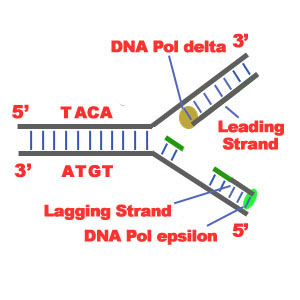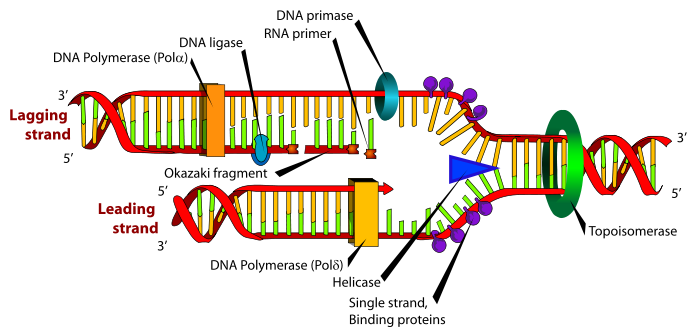Difference between Lagging and Leading Strand

The transmission of one characteristic is transmitted to another through DNA or deoxyribonucleic acid which is present in a person’s chromosome. Note that DNA carries hereditary characteristics to the next generation through replication or making a carbon copy of itself. The double stranded DNA molecule is replicated into two similar copies. Both strands act as templates in order to make a complementary strand. The splitting of DNA produces a fork. Remember that new DNA is synthesized into 5’ to 3’ form. This is why replication leads strands to go in different direction.
Leading strand is replicated in the same direction as the replication of the fork whereas Lagging strand is synthesized in the opposite direction as the replication of the fork.
Leading strand is the DNA strand which grows constantly without any gap. On the other hand lagging strands are those which are made in small parts known as Okazaki fragments. In addition to this, their growth is not continuous. Both leading and lagging strands have different DNA polymerase for elongation purposes.
Leading strand do not requires DNA ligase whereas it is necessary for a lagging strand as this helps in joining the Okazaki fragments.
Development of a leading strand is fast as opposed to a lagging strand whose formation is slower. Further, the formation of a leading strand starts quickly with replication. Development of lagging strand requires a little time as compared to a leading strand.
Instructions
-
1
Lagging Strand
This is a replicating strand which is synthesized in 3’ to 5’ direction. It needs RNA primer and is a non-continuous process. It is synthesized in the opposite way of the movement of the replication fork and this is why it is discontinuous. Remember that primase takes time for the fork to open before inserting the primer.
- Image Courtesy: dnareplication.info

-
2
Leading Strand
Leading Strand does not need an RNA primer and is synthesized continuously in the 5’ to 3’ direction. There is no gap or breaks between them.
- Image Courtesy: stmary.ws








